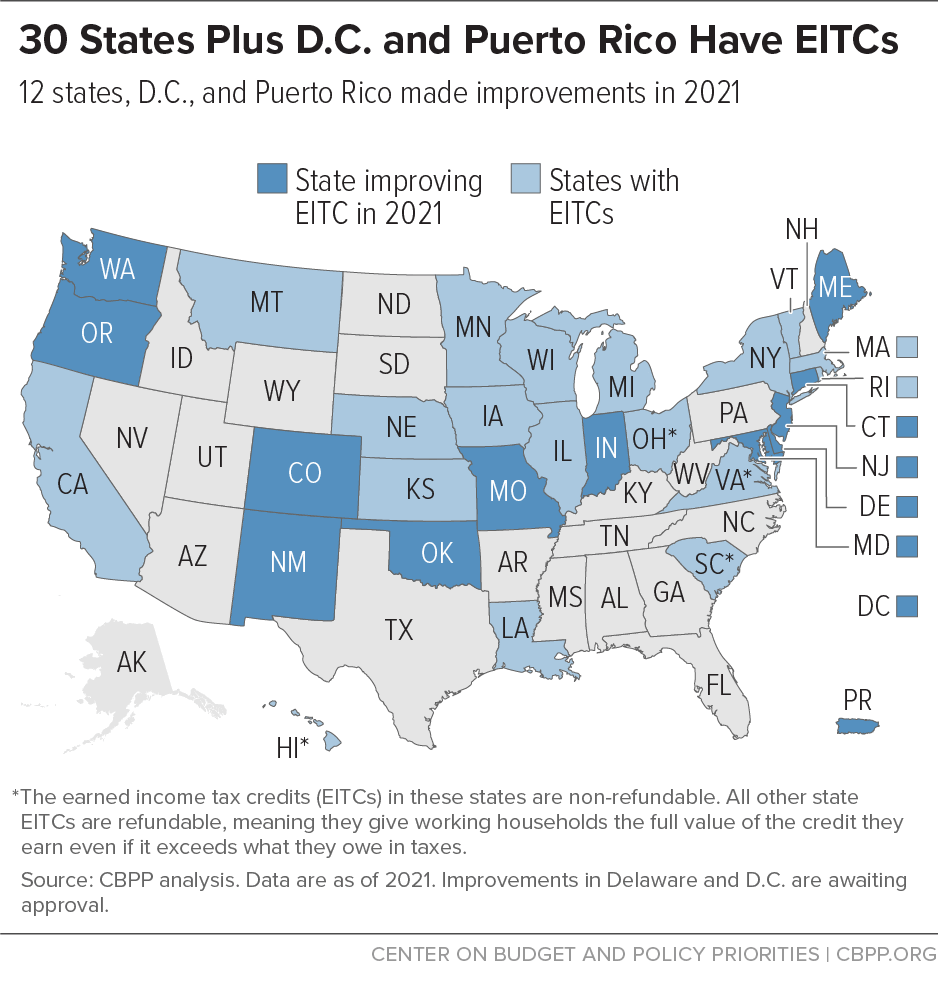BEYOND THE NUMBERS
A Record 14 States, Territories Created or Improved EITCs to Respond to COVID-19
Note: this post is an update of this one, written before enactment of several recent EITC measures.
A record number of states have provided much-needed support for families during the pandemic by enacting bills to create or improve state earned income tax credits (EITCs) this year. Twelve states, the District of Columbia, and Puerto Rico have enacted such measures this year. When fully phased in, these measures will enable over 1.2 million families struggling to afford the basics to newly qualify for state EITCs and will boost tax refunds for many others. These gains represent many years of effort by state advocates and lawmakers who have championed the EITC and its benefits for families, children, and communities.
The hardship from COVID-19 has hit people paid low wages the hardest. Not only have they been more likely to lose jobs and income due to COVID-19, but if they work as front-line, essential workers (and have been able to keep their jobs) they tend to be at higher infection risk for coronavirus. Using Fiscal Recovery Funds from the American Rescue Plan, states have a historic opportunity to limit pandemic-induced hardships — which have been concentrated in Black, Indigenous, and Latinx communities and other communities of color — and build a more equitable recovery and communities.
Along with higher minimum wages, cash payments, and many other options to support people struggling on limited incomes, state EITCs can help families afford the basics now and into the future. These states either created or improved their EITCs this year:
-
Colorado increased its credit from 15 percent to 25 percent of the federal EITC (it will shrink to 20 percent starting in 2026). Colorado also made the EITC for those without children in the home available to 19- to 24-year-olds on a permanent basis. The American Rescue Plan’s expansion in the federal EITC for these families is only temporary and should be made permanent too.
Colorado also funded its state Child Tax Credit, which policymakers had enacted but never implemented. The credit provides up to 30 percent of the federal Child Tax Credit, depending on a family’s income, to families earning up to $85,000, depending on their tax filing status.
- Connecticut restored the value of its EITC, which policymakers had cut in recent years, by increasing it from 23 percent to 30.5 percent of the federal credit. Almost 195,000 households will benefit.
- Delaware made the state’s credit partially refundable by allowing families to choose the higher of a refundable credit worth up to 4.5 percent of the federal EITC or the current non-refundable credit, which is worth up to 20 percent of the federal EITC. A refundable credit is fully available to families even if it exceeds what they owe at tax time, while non-refundable credits leave out families who earn the least.
- D.C. approved a budget that increases the district’s credit from 40 percent to 100 percent of the federal credit for families with children, the largest refundable credit of any state or territory. (The D.C. credit for those without children in the home is already 100 percent of the federal credit.) The increase will phase in, starting with 70 percent in 2022 and reaching 100 percent in 2026.
- Indiana increased its credit from 9 to 10 percent of the federal EITC.
- Maine increased its state credit temporarily for tax year 2021, from 12 percent to 20 percent of the federal credit for the approximately 100,000 families who receive it. The state also made its credit inclusive of immigrants by enabling people without a Social Security number to use an Individual Tax Identification Number (ITIN) to claim it.
- Maryland boosted its EITC twice this year. First, the RELIEF Act expanded the credit for the next three years to 45 percent of the federal credit for families with children in the home and 100 percent of the federal credit for those without children (capped at $530). Maryland also made its credit inclusive of immigrants by enabling ITIN holders to receive it. These changes will boost the credit for 400,000 Marylanders and make an estimated 40,000 more families newly eligible.
- Missouri enacted a new, non-refundable EITC worth 10 percent of the federal credit. It will increase to 20 percent if state revenue rises beyond a certain threshold. Almost 500,000 families will benefit.
- New Jersey, which last year extended the EITC for people without children in the home to those aged 21-24, made further progress this year by making it available to those aged 18-20 and 65 and older. The change will help 90,000 people.
- New Mexico improved its EITC in several ways this year: increasing the credit from 17 to 25 percent of the federal credit (a 47 percent increase), extending it to immigrants who file taxes with an ITIN, and extending the credit for people without children in the home aged 18-24. The same bill also more than tripled the state’s Low-Income Comprehensive Tax Rebate and ties it to inflation going forward so it doesn’t lose value over time.
- Oklahoma, which cut its credit by nearly 70 percent in 2016, reversed course and restored the credit’s full value this year by making it fully refundable. Most state EITCs are refundable, just like the federal credit.
- Oregon made its credit inclusive of immigrants who file taxes with an ITIN, which is estimated to help over 20,000 families. Oregon is the seventh state to make this change; the others are California, Colorado, Maine, Maryland, New Mexico, and Washington State.
- Puerto Rico Governor Pedro Pierluisi signed a bill that increases the territory’s EITC. It stipulates how the annual, federal supplement to Puerto Rico’s EITC provided through the American Rescue Plan Act will be used. The measure increases the maximum credit for workers without children in the home and is now available to people aged 19 and over.
- Washington State finally funded its Working Families Tax Credit, which policymakers created in 2008 but never implemented due to the Great Recession and resulting budget shortfalls. The newly implemented credit provides larger rebates to families and is inclusive of immigrants who file taxes with an ITIN. It’s an instructive example of how an EITC can work in a state without an income tax and will benefit more than 400,000 households.

